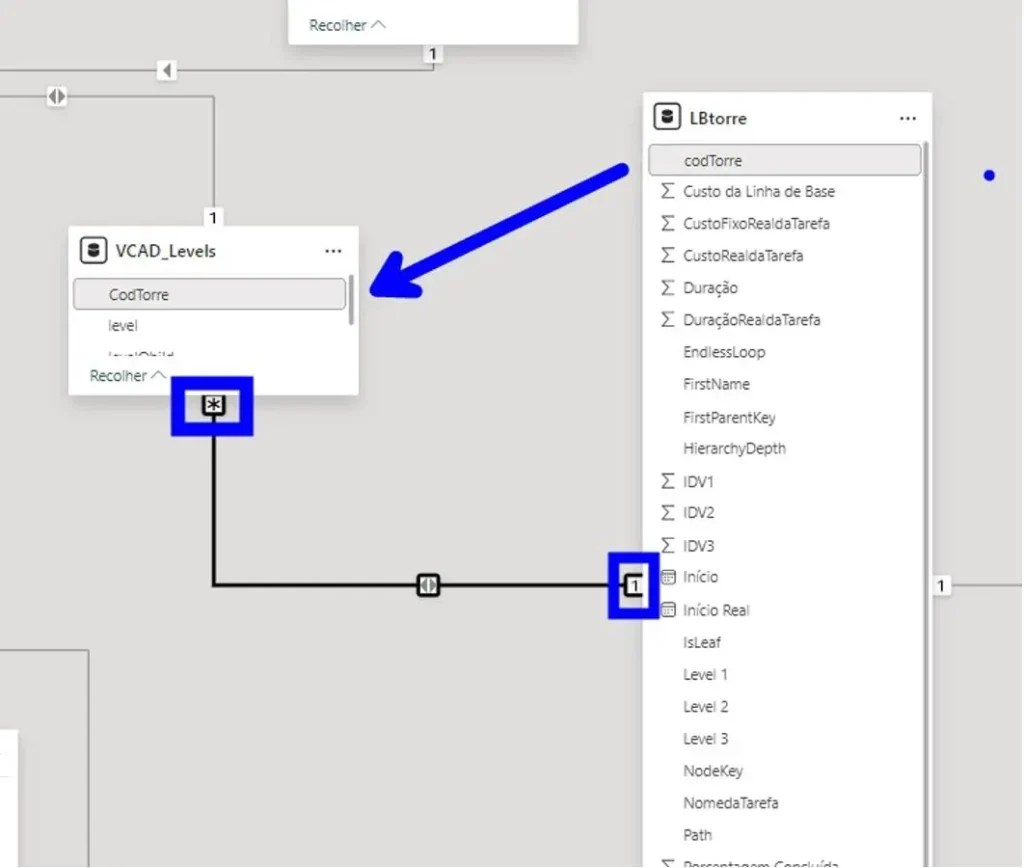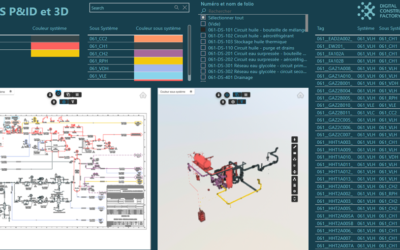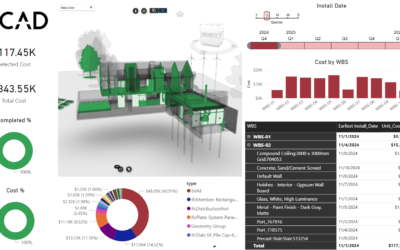Introduction
Construction is rapidly evolving with digitalization, and the use of Building Information Modeling (BIM) is and will be the key to this transformation. The reality of management using 5D is not so far away, the inclusion of the dimensions of cost (4D) and time (5D) will transform the way companies manage their projects, and in this article we will talk about this, about the 5D vision that allows a holistic view of the project, in this case study we will show the integration between the Power BI tools and MS Project (Online – PWA) using Vcad, in this situation we access IFC data and link it to the data coming from MS Project using Vcad.
PMBOK in data structuring
Definition of the WBS
The Work Breakdown Structure (WBS) is essential for breaking down the work of the project into smaller, more manageable parts, just as we know modeling and related entities and dimensional objects are, just like the levels of our project, the work breakdown structure acts as a guide for planning and controlling the project.
This structure is used for the most diverse types of controls in an enterprise or project, from service check sheets to purchase invoices.
Linking EAP with BIM
When looking at the WBS within the BIM scope, it is crucial to understand how we can link financial and time data to the 3D models, this ensures that changes in the project are reflected in the cost and time estimates. Integrating Business Intelligence (BI) in the process, ERP databases also receive project analytical structures for appropriations and controls.
IFC models
IFC (Industry Foundation Classes) files are used to standardize the exchange of BIM data between different software, allowing interoperability and efficient sharing of information, knowing this, one of the options is to integrate the scope of the product into the IFC model. One thing that the PMBOK already tries to emphasize is the difference between a project scope and a planning scope, which are often unrelated in controls. We can have different planning and budget WBS for the same project, but I wouldn’t say that this is good practice. In a world where standardization is essential and adaptation is indispensable, we need to understand how to standardize this WBS, both in the IFC model and in the other data sources involved in a project.
Integration of Power BI, MS Project and BIM for 5D Vision
Common environment generating the 5D vision
What is 5D if not the possibility of visualizing the interaction between 3D, 4D and 5D? Power BI allows the creation of interactive dashboards that centralize data from BIM, MS Project and other sources, and generates an interaction between this data thus creating a common environment for time, cost and dimension, which facilitates the 5D vision.
The 3D link to DEADLINE AND COST
Now that we understand the need for a well-defined WBS, we know that it will contain the work packages that can be in MS Project or even in excel, in our case in Project Online, linked to the three-dimensional entities in BIM, such as floors and building components. This link is made through the WBS codes, which are essential for organizing and tracking activities.
Practical Example

The M Language logic in Power BI can be used to connect MS Project and VCAD data, providing a 5D view where planning, cost and execution are visualized together.

BI and BIM
The role of Business Intelligence (BI)
BI transforms raw data into actionable insights, helping to identify trends, predict risks and improve project performance regardless of the data generated, so in the end the company’s decision-making needs to be guided by a well-defined process and well-structured data, Business Intelligence focuses on exactly these concepts.
BI tools such as Power BI
Power BI is a powerful tool for data visualization, so we still need to understand that both technical knowledge from the PMBOK and good modeling practices are necessary to enable the creation of reports and dashboards that help understand and analyze construction projects.
Standards and practices
Global adherence to BIM
Many countries are adopting BIM as a legal requirement for construction projects, driving high standards of efficiency and quality. For example, the UK has led the way with BIM Level 2, required for all public projects since 2016. Other countries such as Norway, Finland and Denmark also have strict standards for the adoption of BIM.
In Brazil, for example, from where I write this article, the ISO NBR 19650 standard establishes guidelines for information management in BIM, promoting consistency in projects. The Brazilian government is encouraging the adoption of BIM in infrastructure projects, as part of the National BIM Dissemination Strategy (Estratégia BIM BR).
Integration for 5D vision
Now, how does EAP Integration and Modeling in IFC Files work in practice?
The Key Point of Integration
True integration lies in modeling and making the WBS available directly within the IFC file. This allows the project structure to be reflected in the model data, facilitating coordination between different teams and systems.
Alternatives with M Language
When the EAP is not available in the IFC file, we can use the M Language in Power BI to create custom integrations. This approach allows external data and design structures to be incorporated into the BIM environment, even if they are not originally part of the IFC file.
Ideal scenario
The best scenario occurs when the WBS comes directly from the data model, allowing seamless integration between all aspects of the project, from planning to execution. However, this usually requires the use of additional applications to integrate 4D and 5D effectively. In today’s market, many companies still rely on Excel and MS Project for project management. This reality may delay the adoption of the ideal scenario, but it is a goal that companies should aim to achieve.
Conclusion
Integrating the Analytical Design Structure with BIM, using tools such as Power BI and MS Project, is crucial for the effective implementation of 5D BIM. By connecting cost and time data to three-dimensional models, it is possible to obtain a more accurate and comprehensive view of the project, promoting efficiency and innovation in the construction industry.
Case study by José Henrique Bassani Linck
José Henrique Bassani Linck is a civil engineer specializing in Controlling Business Management and Corporate Finance who founded JHBL Engineering and Business Intelligence. Always very curious about market innovations, he has created MVPs focused on 5D solutions for the construction industry, always looking for the best tools and best practices to transform the way construction companies run their business.
He founded the YouTube channel where he shares free content with Power BI applied to civil construction.











